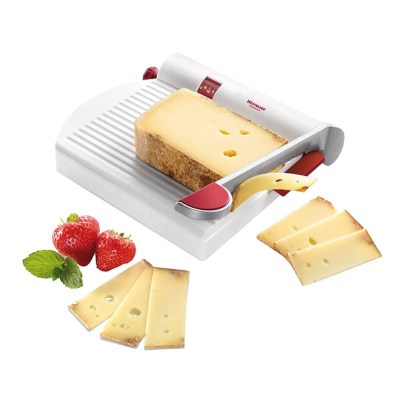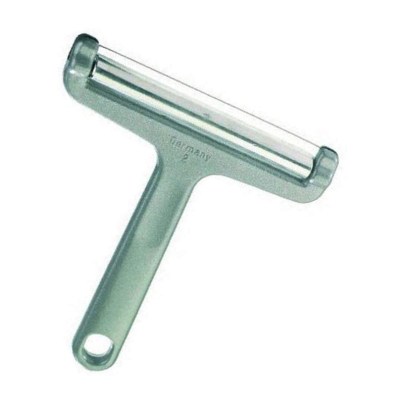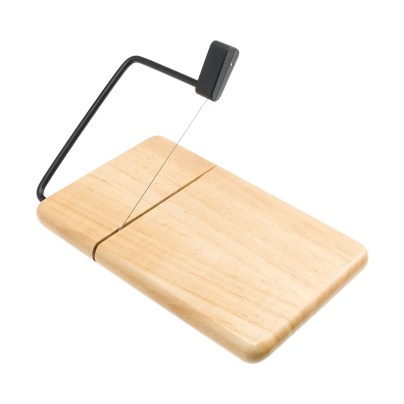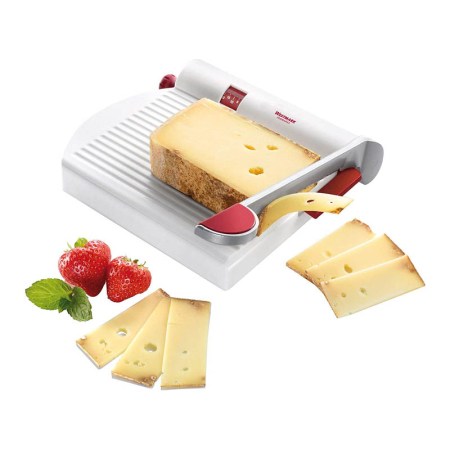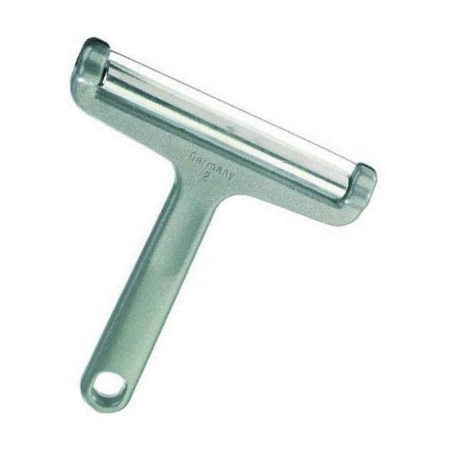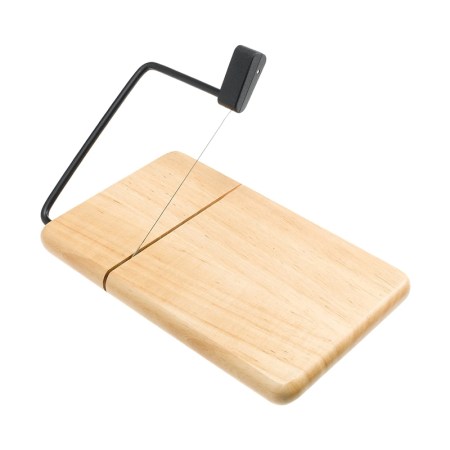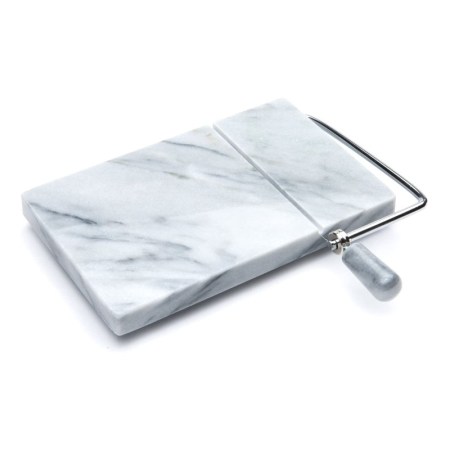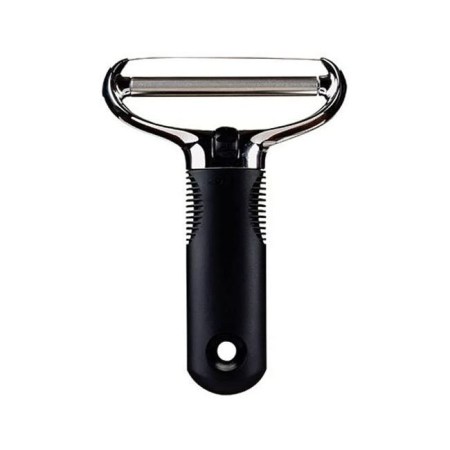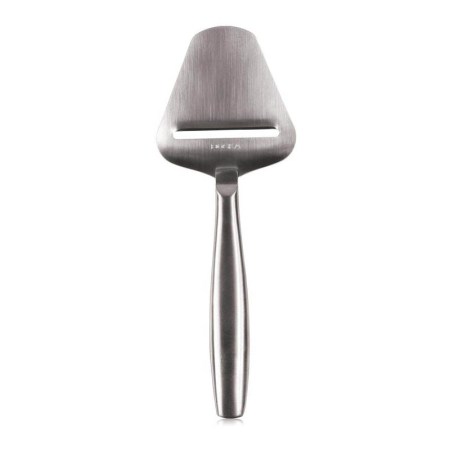We may earn revenue from the products available on this page and participate in affiliate programs. Learn More ›
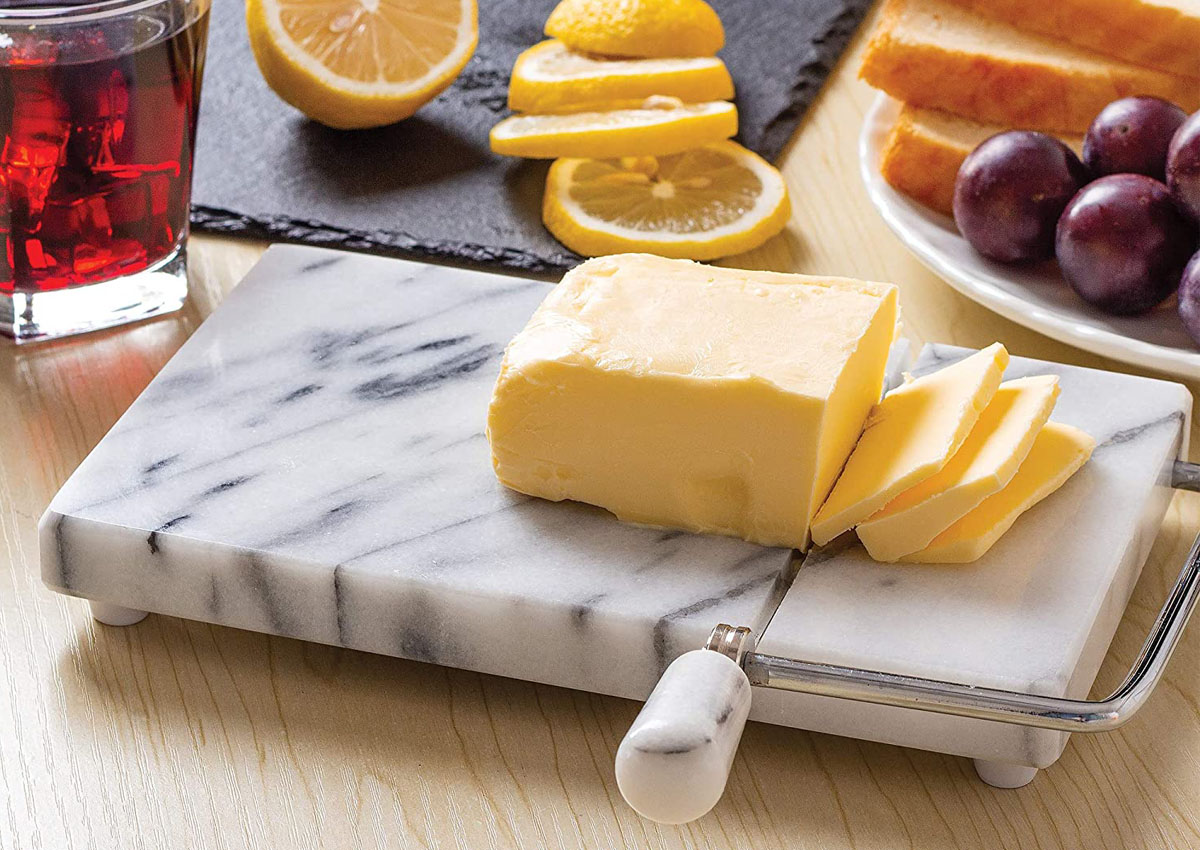
Using the right tool for the job is important for food prep. Any professional chef will tell you that a paring knife is more suited to delicate work, such as peeling vegetables, than a general-purpose kitchen knife would be. The same goes for cutting or slicing cheese—a cheese slicer is a specialized tool that gives you the best results possible.
Read on to learn about the characteristics of quality cheese slicers and what distinguishes different types. Along the way, be sure to check out our roundup of favorites among the best cheese slicer options available today.
- BEST OVERALL: Westmark Multipurpose Cheese and Food Slicer
- BEST BANG FOR THE BUCK: Westmark Heavy Duty Wire Cheese Slicer
- BEST WOOD: Prodyne Thick Beechwood Cheese Slicer
- BEST MARBLE: Fox Run Marble Cheese Slicer with 2 Replacement Wires
- BEST FOR DAILY USE: OXO Cheese Slicer with Replaceable Wires
- BEST FOR HARD CHEESES: BOSKA Copenhagen Cheese Slicer
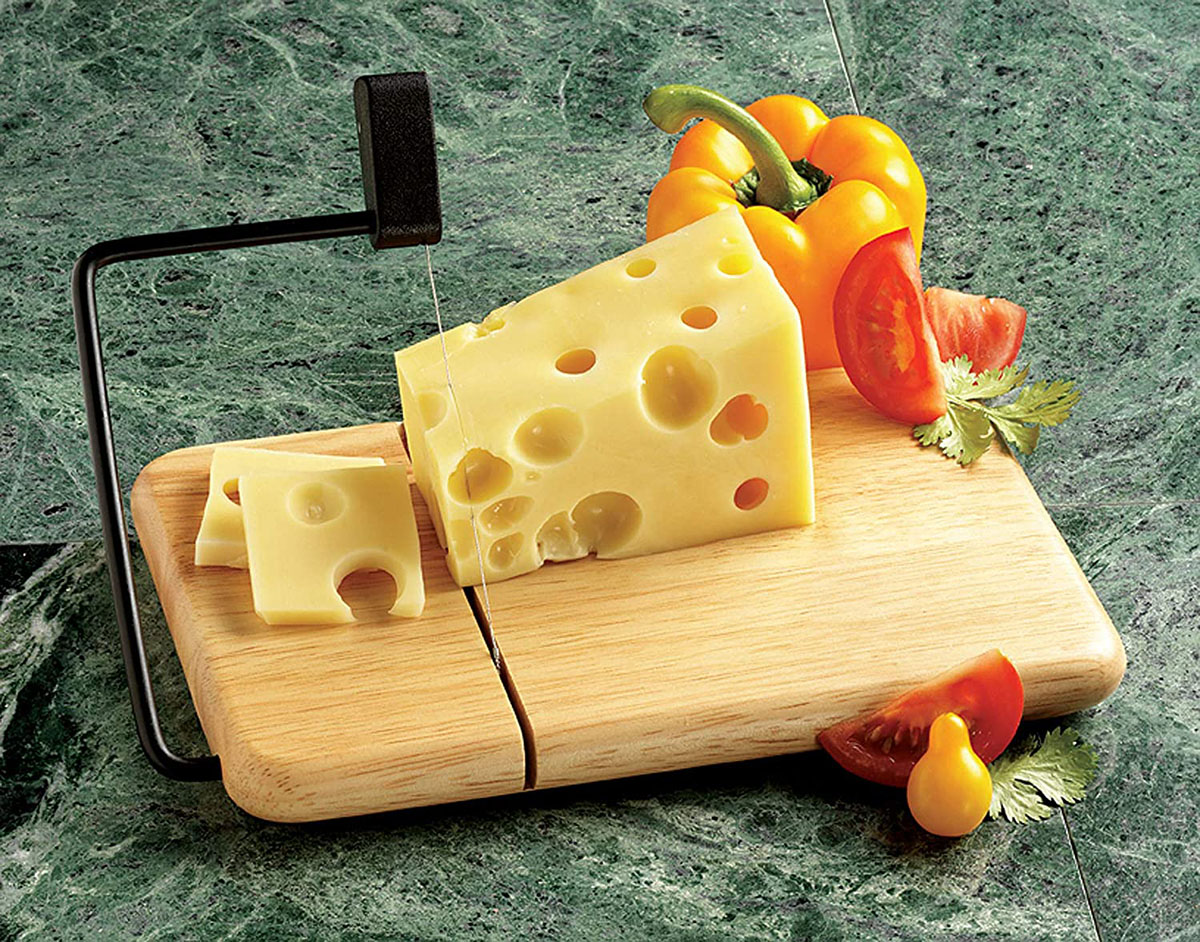
What to Consider When Choosing the Best Cheese Slicer
There are different forms and styles of cheese slicers, and some can cut foods other than cheese. If you’re trying to figure out which style is best for your needs and budget, read on.
Handheld vs. Base Models
Handheld models come in two styles. One type is a slingshot, or Y-shaped, model that slices cheeses with a taut wire stretched parallel to the blade. For some models, the tension on the wire can be adjusted.
The other handheld design features a shaving blade inserted in the middle of a shovel-style head. Operating a tool like this means drawing the blade or wire across the top of the cheese to create a shaving.
Base, also known as block, models are designed for use on a countertop or tabletop. These apply a guillotine-like cutting motion with a wire or steel blade. Some cheese slicers of this type can actually function as a serving board.
Material
Stainless steel is the most common material used for blades and cutting wires. Steel is one of the few metals that can be considered food grade. It’s also tough enough to cut through harder cheeses that have a moisture content of less than 50 percent, like Romano and Parmesan.
The base portion of these models are made from various materials like metal, wood, plastic. Functionally, these materials are similar. The variety has more to do with personal preference, as some prefer the natural look of wood, others prefer nonporous steel, and some choose plastic cutting surfaces.
The bodies of handheld models are usually constructed of lighter, more durable materials like zinc alloy. Plastic handles, some featuring a silicone sleeve, are also common for comfort and ergonomics.
Comfort
Comfort is important when it comes to handheld cheese slicers. If you had a large amount of cheese to cut, your wrist and hand take the brunt of the stress. A strong handle helps with steady and constant pressure during cutting, and the shape or contour can reduce strain. Ergonomic handles also can mitigate wrist and grip strain.
Base/block models have large handles that allow you to put pressure on the blade without straining. When it comes to cutting cheese, most of the work is done by the blade, if it’s sharp enough. It’s generally easier to slice cheeses using a base/block slicer. Keep in mind that these models take up more storage space.
Adjustable Thickness
There is more room for flexibility in thickness when cutting with a base/block-style cheese slicer, because you can move as much or as little of the cheese block under the wire or blade as you like. While you can cut a 2-inch-thick piece of cheddar with the base/block model, cheese slicers are better suited for thinner slices.
Some wire-bladed handheld models have adjustable rollers that can vary the thickness of cuts. Pie-serving-style handheld slicers cannot adjust thickness, but you could layer the slices to increase the thickness.
Versatility
Cheese slicers also can be used for cutting other foods. Base/block models fine-slice foods like sausages, peppers, lettuce, cucumbers, and radishes. If a base/block model uses a hard-edge blade instead of a wire blade to cut, then there are more options for the types of food they can process. Wire blades don’t usually have the strength to cut through meats like salami or harder foods like nuts.
Handheld-style cheese slicers are more suited for hard or semihard cheeses. Base/block-style slicers can cut hard, semihard, semisoft, or soft cheeses with equal success.
Safety
Using a cheese slicer requires the same level of caution as using any standard kitchen knife. Cut away from your body, and keep the blades sharp. More caution is needed with a straight-edge blade than a wire blade. Wire blades on cheese cutters are generally safer because they are less likely to cut through meats or harder foods.
Our Top Picks
Now that you know more about cheese slicers, it’s time to start shopping. Using the factors listed above, we selected several effective, well-built cheese slicers. Here are our top picks for some of the best cheese slicers for hosts to create their next party tray.
Best Overall
Westmark Multipurpose Cheese and Food Slicer
See ItWestmark’s cheese slicer can be used not only for cheese, for many other foods as well. Its high-grade steel blade slices soft and hard cheeses, as well as sausages, peppers, lettuce, cucumbers, and radishes.
By turning a dial on the slicer’s side, you can adjust the slice thickness. Place cheese on the cutting board, then slide it to the red guard and slice away.
The board provides room for your slices until you’re ready to eat or serve them. The rubber contacts at the bottom of the board protect your countertop and prevent slippage.
Note that this Westmark cheese slicer can only be washed by hand with soap and water.
Best Bang for the Buck
Westmark Heavy Duty Wire Cheese Slicer
See ItIf you’re looking for a heavy-duty, inexpensive cheese slicer, consider this handheld tool from Westmark. It’s suitable for both hard and soft cheeses, and slice thickness can be changed by adjusting the cutting angle while using the too.
The slicer features high-quality metal parts, including a wire and roller made of stainless steel, as well as a handle made of cast aluminum. This sturdy and easy-to-use slicer is built to last for years.
Cleaning is simple and requires only soap and water.
Best Wood
Prodyne Thick Beechwood Cheese Slicer
See ItThis model has a sleek black arm and a stainless-steel cutting wire that sinks easily into the hardest cheese for thick or thin slices. The natural beechwood base is attractive enough to use as a serving board or party tray, offering two-in-one functionality.
The Prodyne cheese slicer board features nonslip rubber feet that help prevent unwanted movement or damage to countertops. Washing by hand with mild dish soap will keep this wood slicer in good shape.
Best Marble
Fox Run Marble Cheese Slicer with 2 Replacement Wires
See ItFox Run offers an elegant cheese slicer block made of 100 percent marble. The stone features unique patterns and color variations characteristic of this natural stone. The slicing lever even contains marble, like the base, for a cohesive aesthetic.
The non-stick surface is ideal for cutting and serving, while the stainless steel wire slices through hard and soft cheeses, with adjustable thickness to suit your preferences. This slicer includes two replacement blades and plastic feet on the bottom to protect countertops.
Wash the Fox Run cheese slicer with mild soap and rinse thoroughly with warm water. Since marble is porous, soap can leave a trace taste or scent if the block is not rinsed thoroughly.
Best for Daily Use
OXO Cheese Slicer with Replaceable Wires
See ItIf you anticipate needing to slice cheese regularly, you may want to go out of your way to choose a cheese slicer that won’t tire out your hands. Consider this OXO model, which features a comfortable handle with indents for a secure grip.
Seated at the top of the handle is a dial for adjusting the wire tension when cutting cheeses of differing densities. Another nice feature is that OXO’s cheese slicer is conveniently dishwasher-safe.
Two replacement wires are included, and the wire is easily replaceable by using the same handle dial used to adjust the tension.
Best for Hard Cheeses
BOSKA Copenhagen Cheese Slicer
See ItThe blade on this premium cheese slicer is made out of a single piece of high-quality stainless steel. This lightweight design has been used for decades, and BOSKA engineered the handle for ergonomic comfort. The shovel-style head containing the blade is easy on the wrist, as most of the force you exert is pulling as opposed to pressing.
Ideal for hard and semi-hard cheeses, this dishwasher-safe design does not work well with soft cheeses like Brie, Camembert, or Roquefort.
FAQs About Your New Cheese Slicer
If you still have lingering questions regarding your cheese slicers, below are answers to some of the most commonly asked questions. Bon appétit!
Q. Do professional chefs use cheese slicers?
Professional chefs will definitely use the best tool for the job. A dedicated cheese slicer is ideally suited to the task for which it was named.
Q. How do you slice cheese with a cheese slicer?
If it’s a countertop wire cutter, a guillotine-like motion will slice the cheese. Handheld versions require a combination of pulling-and-pressing pressure to cut slices.
Q. Do cheese slicers last long?
The length of time cheese slicers last will depend on how often they’re used, the material, and construction. Wires or blades do not last as long if you tend to cut harder cheeses like Gouda or Romano. Stainless steel is the most durable material for cheese slicers, as opposed to plastic.
